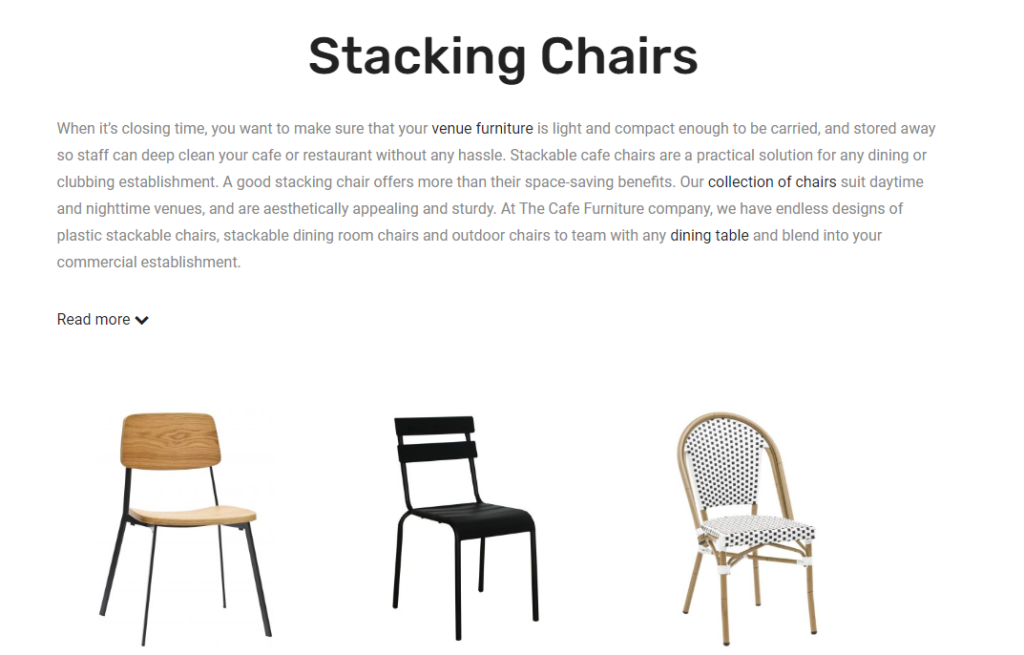Category pages and subcategory pages are often overlooked when writing content that converts an eCommerce website.
If you are keen on making your category pages dominate in Google search results, and deliver a great experience for your users, you’re going to have to put in some elbow grease.
In this article, we outline everything you need to know on how to create compelling content that converts your new prospects into customers!
Why should I have written content on my eCommerce category pages?
Having well-written content for each of your categories can:
- Outline what is most important in each of your collections
- Give old and new customers introduction and context
- Allow you to utilise secondary calls to action
- Provide information to search engines (like Google) regarding the content and the purpose of the page
How long should my category content be?
No need to write a book.
When it comes to writing category content, you should find a balance between concise, descriptive and informative.
As a rule of thumb, we generally advise 300 to 450 words to pages that you want to rank with or roughly two short paragraphs as a guideline.
However, it can be difficult for you to get up to 300 words for product writers, especially if some products don’t offer enough inspiration for lengthy pieces of copy, even if they are an integral part of your brand. If this is the case, don’t be afraid to write less, as long as you include the necessary keywords and relevant information about your categories and products for your target audience.
Writing for a very niche product or category that requires a more complex copy for your users to gain trust in their purchasing decisions? Try creating a separate page or guide and link it from your category.
Alternatively, consider researching your focus keywords intent to understand your target audience.
Then by applying your most important content on top of the fold for the user & Google to read. If you have a large quantity of content you can use an anchor link to link the rest at the bottom of the page.
This entails writing a one or two liner opening at the top of a category page, which typically gives a general overview of the product on offer. This is followed by writing a more detailed copy at the bottom of the page. This copy gives more detailed information about the product, or outlines any questions users may have about the category.
Here’s an example:
Bisley Workwear is a clothing brand specialising in manufacturing premium quality workwear and PPE clothing for men and women in trade. While the brand offers a variety of products, Bisley also offers an assortment of clothing sizes so that the brand’s target audience can find the exact fit of shirts, jackets or pants they require.
This is our content for their men’s workwear:

What to include in your content for your category pages
Category page content should give your users a strong idea of what or why they need to shop in that specific page. To put it more accurately, your copy should give users what you (as a brand) think they need to make an informed purchasing decision.
As a rule of thumb, your category content should accomplish the following goals.
Basic overview of the product type offered in the category:
- Explanation of features, uses, brands, etc.
- Advantages of your product offerings
- Creative headlines that highlight your offerings (a great opportunity to input high-intent keywords)
- Call to action or follow-up messages (e.g., Can’t find what you’re looking for? Don’t hesitate to reach out to our customer support team and we’ll find you the right solution)
A tip: Try not to overuse particular keywords or write overly generic copy. Try to make your content original for every category page if possible.
Category examples
Category content doesn’t have to be complex. We’ve listed some of AdVisible’s best examples below on what high-converting category content looks like.



Things to consider when writing converting category content
Prioritising your categories
Curating well-written category content for your eCommerce store is going to take time and practice, especially if you have a lot of products to sell.
This is why it’s important to prioritise your categories. Begin with your top-level categories then pick the ones that are most important to your online brand, and business.
We suggest the following two approaches:
- Begin writing your most profitable categories, such as your “bestsellers” or,
- Start with profitable categories that aren’t selling to your liking or aren’t getting much online traffic.
Whatever category you start with, it makes the most sense to begin writing content for categories that offer the most value to your business. Why? Because having no written content won’t help anyone. If you want your online business to compete and deliver a richer experience to your visitors, you need to start writing content right away.
Focus on your target audience first, the all-knowing Google second
It’s easy to get caught up in the chaos of high-intent keywords, backlinks and other strategies to drive your SERP ranking upwards.
Don’t forget, your primary focus is delivering content for your potential customers.
You should always write compelling and thorough descriptions for each category and product. Your online customer needs to know as must information as possible to make an educated purchasing decision.
Solid category content not only helps customers in determining the product itself, but it also helps to build trust in your online brand. Online consumers don’t have the opportunity to test the goods or see them in person, so your job is to ensure they will always receive the finest quality possible. Furthermore, accurate and thorough product descriptions allow you to establish credibility with customers and boost potential sales.
But my competitor’s website ranks really well for the so-and-so category and it doesn’t have any copy!
This might be true for some of the bigwigs out there, (think Amazon) who don’t have content on their main category pages, so why should you?
The main problem with this line of thinking is that you’re assuming that your brand is on equal ground with this big box store. Amazon has significant notoriety, so many people will automatically go to them when they need something.
Your brand, on the other hand, may not be as well-known or popular.
Therefore, implementing category content could be the winning ticket to get your brand noticed online. on the other hand, may not be as big or popular as your competitors, so use the trick of category page content to get yourself noticed.
After all, it’s your job to do everything in your power to surpass or have an equal footing to your main competitors.
Your category pages can be treasure troves of traffic. A lot of visitors find their way to category pages first before they go to specific web pages of products that they’re interested in. It would be a waste if you didn’t optimize these pages to get more traffic.
Key takeaway
To round off, your category page is an essential component of your eCommerce website.
Many individuals go to this page before clicking on subcategories or visiting a specific product page. So, why not ensure your category page is optimised to attract even more visitors? Quality content on your e-commerce category pages keeps customers informed about the items in that collection. It also helps search engines index your category pages properly, leading to higher customer flow volume and a better ranking in SERPs.
Need eCommerce content that converts and advertises your products to the best they can be? Get in touch with our SEO experts at AdVisible!
Frequently Asked Questions:
Create fun and attractive headlines that can capture attention and add value to your product offerings. For example, instead of a generic title like “Men’s Clothing Collection,” you can write “Elevate Your Style: Discover Premium Men’s Clothes for Every Occasion.”
Incorporate high-intent keywords related to your products or target audience, such as “premium,” “men’s fashion,” or specific garment types. Write personalised headlines that resonate with your brand and appeal to the interests and preferences of your target customers.
When writing category page content, avoid common practices such as keyword stuffing, generic descriptions, and neglecting to personalise content for each category.
Instead, focus on providing valuable information that educates and inspires visitors. Strive to maintain a conversational tone, address customer pain points, and highlight unique selling points to keep readers engaged and interested in exploring what you offer further.
Prioritising categories requires evaluating factors such as profitability, popularity, and relevance to your target audience.
You can start by identifying top-level categories that drive the most revenue or align with your brand’s core offerings; consider categories that have the potential for growth or improvement based on market trends or customer feedback. Regularly review and adjust priorities based on performance metrics and evolving business goals.
You can use analytics tools and data analysis techniques to identify profitable categories and prioritise content creation. You can also track metrics such as sales revenue, conversion rates, and average order value for each category to gauge performance.
In addition, SEO analysts can conduct keyword research to find search trends and identify high-demand product categories within your niche. Additionally, you can gather insights from customer surveys, feedback, and browsing behaviour to understand which categories resonate most with your target audience.





